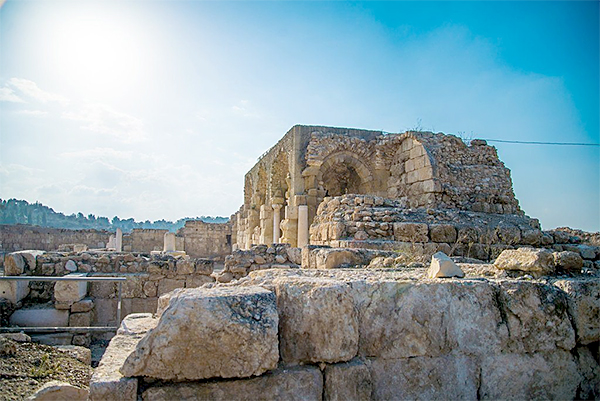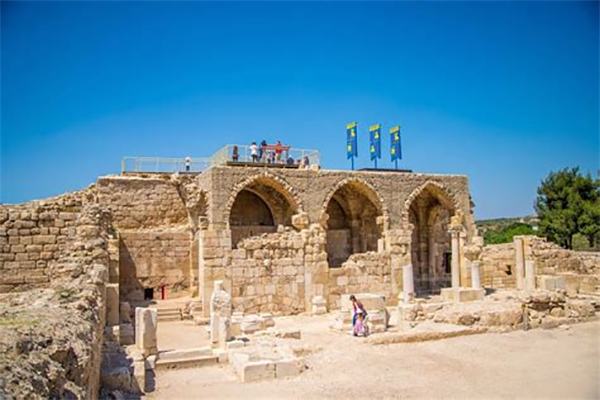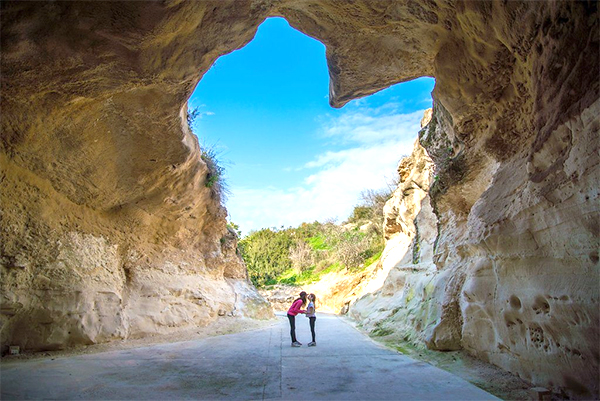Bet Guvrin – Maresha National Park is at the very heart of the “Land of a Thousand Caves”.
History and archaeology
The settlement whose remains are found at Tel Maresha was founded in the early Israelite period, and continued to exist until the late Hellenistic period. The settlement was destroyed in 40 BCE during the fight between the Hasmoneans and Herod. After the destruction, the community moved to nearby Bet Guvrin, where there was an important settlement in Roman and Byzantine times. On the ruins of this settlement, a small fortified town was built during the Crusader period.
The Olive Press – the olive press is one of 22 underground olive presses from the Hellenistic period that have been found at Maresha to date. In the cave is a reconstruction of an ancient installation for pressing oil.
Reconstructed home – a partly reconstructed building used for accommodation and commerce during the Hellenistic period. The ground floor covered an area of 150 m², and its rooms were built around a small central courtyard. A staircase led to a second story. The walls of the house have been preserved to a height of 1.5 m. Under the floor in one of the rooms, a hoard of 25 coins was found. The latest of the coins was minted in 113 BCE, apparently shortly before the house was destroyed by John Hyrcanus I, who conquered Maresha. Water cisterns were found underneath the house, collecting rainwater in clay pipes and channels from the alleys, roofs and courtyards.

Underground system (61 caves) – an incomparably impressive system of underground spaces, built during the Hellenistic period. The path passes through openings broken in the walls separating the spaces, in which there are cisterns, a columbarium, and store rooms.
The Bathtub Cave – two small chambers in which seats were carved for the use of bathers. The water flowed over the seats in channels and funnels installed in the rock walls.
The Sidonian Burial Caves – these are just two of many caves carved out by the Phoenicians living at Maresha. Large alcoves were made in the caves, in which the dead were laid, and the walls were decorated with paintings and inscriptions. One cave is called the Apollophanes Cave, because an inscription was found in it commemorating Apollophanes son of Sesmaios, leader of the Sidonian community in Maresha. The ancient paintings in this cave have been reconstructed on the basis of the drawings of archeologists John Peters and Herman Thiersch, who discovered the place in 1902. In the adjacent cave are reconstructions of paintings of musicians.
St Anne’s Church – the remains of a large church built in the Byzantine period, which was apparently the largest church in the land of Israel in its time. The church was renovated on a smaller scale during the Crusader period. The Arabs called Tel Maresha “Tell Sandahanna”, after the church.

Bet Guvrin in the Roman period:
After the Bar Kochba revolt (135 – 132 BCE), Bet Guvrin became the central city of the district of Idumea. In 199/200 CE Caesar Septimius Severus awarded some of the communities in the province of Syria-Palestinae the status of polis, and Bet Guvrin was one of these cities. The city began minting its own coins in 200 CE, and marking them with its official name -Lucia Septimia Severa Eleutheropolis, or Eleutheropolis (City of the Freedmen) for short. At this time splendid public buildings began to be constructed here, such as the amphitheater and the bathhouse.
The Byzantine period:
During the Byzantine period Bet Guvrin was an important Christian center, the Bishop’s seat and one of the five largest cities in the land of Israel. There was also a large Jewish community at Bet Guvrin, its name mentioned in the Talmud and in the midrashim, and sages such as Rabbi Yonathan of Bet Guvrin and Rabbi Yehuda Ben Yaacov. The remains of Jewish tombs and a synagogue inscription from this period have been found at Bet Guvrin.
Following the Arab conquest (in the 7th century), the place became known as Bet Jibrin, a name that preserves the ancient Arab name of the city. It lost its former glory, but continued to be an important local center.
The Crusader period:
In 1099 CE, the Crusaders conquered the land of Israel and established the Kingdom of Jerusalem. The kingdom came under continuous Muslim attack. Ashkelon, which remained in the hands of the Muslims until 1153, was of particular concern to the Crusaders. In 1131 Fulk of Anjou came to power. Under his rule, the kingdom tried to establish itself in the areas under its control, rather than setting out to attempt further conquests.

Accordingly, in 1134 Fulk decided to fortify the southern border of his kingdom, and built a fortress at Bet Guvrin. The excavators identified the square Crusader fortress with a number of concentric defensive strips at this site as being the earliest model of this type in the land of Israel and the entire Levant. Following on from the fortress at Bet Guvrin and the policy of fortification, additional fortresses were built around Ashkelon at Yavne (Ibelin, 1141) and at Tel Tsafit (Blanchegarde, 1142).
In 1136, the fortress was handed over to the Knights of the Order of St John (the Hospitallers). They expanded the fortress and reinforced it considerably, and under their protection a civilian settlement developed around it. After the Crusaders abandoned the fortress, Bet Guvrin, like the land of Israel as a whole, came under the control of the Ayyubid Muslims.
The Crusaders returned for three years, under an agreement signed with the Ayyubid Sultan al-Malek Salah Ayyub, ruler of Egypt, and then finally abandoned the place in 1244. During the Ayyubid and Mameluke periods the local residents continued to use the spaces of the fortress, and even turned the northern aisle of the church into a mosque.
During the Ottoman period, the village of Bet Jibrin was built on the ruins of the fortress and the Roman city.
The main sites in the northern area
The amphitheater – a remarkable building, built according to the best Roman tradition, for fights between gladiators or against wild animals, and for mass ceremonies. The amphitheater is well preserved, and it is possible to visit the vaults that supported its galleries, the arena, and the underground tunnels through which the competitors and the wild animals entered the arena. On the western side of the vault an altar was found, apparently a site of ritual worship for the competitors before entering the arena. The amphitheater could seat 3500 people.

Bathhouse – the remains of a large Roman bathhouse, with an area of over 5000 m². This is the first bathhouse in the land of Israel built according to the Roman bathhouse design. The builders constructed vaults in order to overcome the slope descending to the Guvrin Stream and allow enough room to build the huge structure.
Crusader fortress – the Crusader fortress is considerably smaller than the Roman city, but its plan was very much influenced by the buildings of the city. The Crusaders used parts of the ancient city walls to build the fortress, and it was built in two stages.
The Crusader church – the church was built up against the southern wall of the inner fortress. It is a typical basilica, with a nave and two aisles. To build the church, the Crusaders used columns, capitals, floor tiles, and any other ancient architectural item they could lay their hands on. The church is very large, considerably greater than required by the population living in the fortress, and it may be assumed that it served the residents of the area as well, and perhaps also pilgrims.
The inner fortress – the fortress was built on the foundations of the Roman bathhouse, and remains of the two periods are used here indiscriminately. It was possible to hide in the impressive inner fortress in the event that the outer fortifications fell. A wooden path runs across it, going through the fortress dining room and other parts of the fortress, and ending in an impressive set of vaults from the Roman period, which served as the foundations of the bathhouse.